|
Ancient to Modern
The changing Egyptian Attitude to Animals
How different the world is for animals in Egypt now. Animal worship is long forgotten. Exotic animals of the wild and of the old Egyptian savannah have long gone. The days of the Pharaoh and the hunt will not be repeated. Multiple species are extinct here. Preoccupation out of modern poverty is preoccupied only to use animals for food, transport or in pursuit of tourists.
They are a commodity fallen from the grace of worship and idolatry. The animals have to eat, but their eating is a barrier to profit and gain. The cat has reverted back to a chaser of vermin. The dog has been forced back to the role of scavenging cur. The donkey is required to perform as a vehicle of burden with super powers. The horse and the camel as tourist cash machines which unfortunately have to be fed and tended.
Tourism has dried up since the social revolution. What feed can be bought is now fed in ration, and the animals face slow starvation which is already taking place. At night when the saddles are removed… the bones and ribs of the emaciated animals can be seen everywhere.
The husbandry generally is carried out to the barest minimum standard or not at all. Conversation is through the lashing of a whip. Life is the numbness of pain from huge festering sores hidden under tourist saddles.
What has gone wrong ?
Where has the humanity gone ?
Where has the respect even for the teachings of the Quran gone?
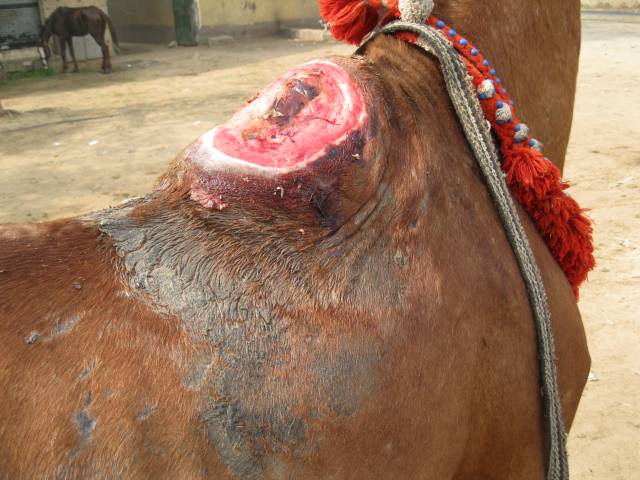 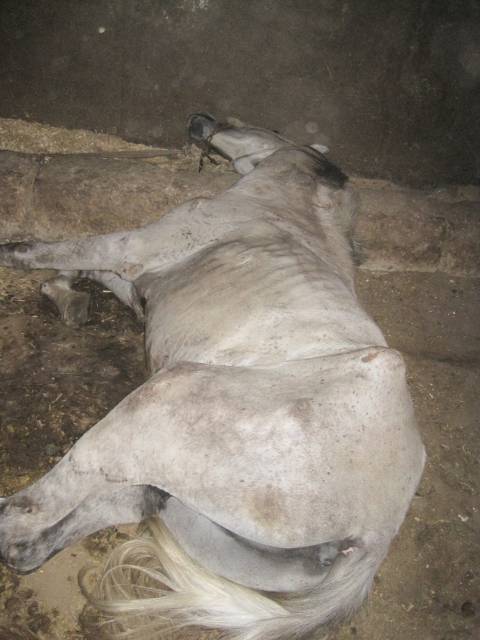
As It Was Before
The conventional history books tell us that animal domestication took place in Egypt in time with settlements which emerged along the course of the Nile from 6ooo years ago. However the relationship of people and animals is easier to understand from Islamic record and from the Quran itself.
In the Quran over 200 verses mention animals and there are 6 chapters named after animals.
From http://en.wikipedia.org/wiki/Islam_and_animals#cite_ref-EoR.26N_1-4
We get : The Qur'an applies the word "Muslim" not only to humans but also to animals and the inanimate world.
"The divine will manifests itself in the form of laws both in human society and in the world of nature."
In Islamic terminology, for example, a bee is a Muslim precisely because it lives and dies obeying the Sharia that God has prescribed for the community of bees, just as a person is a Muslim by virtue of the fact that he or she submits to the revealed Sharia ordained for humans in the Qur'an and Sunnah
The Quran strongly enjoins Muslims to treat animals with compassion and not to abuse them. The Qur'an states that all creation praises God, even if this praise is not expressed in human language.
In verse 6:38, the Qur'an applies the term ummah, generally used to mean "a human religious community", for genera of animals.
The Encyclopaedia of the Qur'an states that this verse has been "far reaching in its moral and ecological implications."
There is not an animal (that lives) on the earth, nor a being that flies on its wings, but (forms part of) communities like you. Nothing have we omitted from the Book, and they (all) shall be gathered to their Lord in the end.
—Qur'an 6:38
Have the Social/Economic changes in Egypt over the last 3000 years been so great – that they may explain the high level of animal abuse throughout Egypt now – and in direct defiance of the Quran ?
…………………………………………………………..
From time immemorial people have aspired to the best qualities seen in animal behaviour. In ancient times when life was simpler, it would have been much easier to transfer these observations into the everyday world.
Even in the stars the symbolic status of animals is immortalised in the stellar constellations. Modern history fixes animal descriptions in the constellations from about 3000 years ago and they were clearly defined by the Greek scientist Ptolemy in 150AD.
However this definition misses other important evidence because there was another constellation which was missed or ignored. ‘Ophiuchus’ appears due to Precession, every 10.500 years and is visible again in time for the passing out of 2012. Ophiuchus is the Serpent bearer and there are many connotations within Egyptian life from this Serpent.
It was symbolic more of Agathodaimon, who was the good spirit in the form of a serpent, uniting the higher domains with the netherworld of the Duat.
Throughout the history of modern Egypt animals have conveyed status. It is obvious that owning high numbers of domesticated animals reflected a person’s wealth and estate. Animals were bred and owned for their inherent high qualities, or were collected for their wild exotic status; and in many instances wild animals were tamed sufficiently for handling as a showing of ultimate status. Animals were elevated within society. They were treated well and respected, and even revered or worshipped as symbolic gods. Many of these symbolisms and their important implications are dealt with in our .info site.
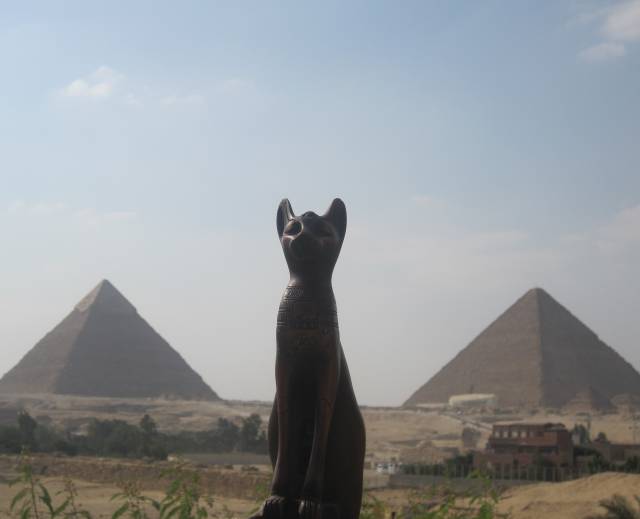
It is said that the Prophet Muhammad cut the sleeve of his coat rather than disturb his sleeping pet cat Muezza, and that the stripes in its fur were from his hand stroking it.
Medieval donations were elicited from followers of Sultan Baybars 1260/1277AD to maintain a garden for destitute stray cats near the Mosque. Heraldic emblems of the Baybars used even on coins were the prancing lion or the panther.
Small Egyptian amulets representing cats may date from as early as 2300 B.C.E. The oldest picture of a cat was found in the tomb of Baket III. It dates from 1950 B.C.E. and shows a cat confronting a rat
http://www.freerepublic.com/focus/news/833609/posts
There is a cat known as the African wild cat (Felis silvestris libyca)-one of the closest wild relatives of the modern cat. It is larger than the average domesticated cat of today. The feline's tawny, yellow-gray fur, long tapering tail and striped markings, affording it ideal camouflage among the rocks and sand of the desert. This cat is known as a predator-a hunter of small game-rather than a scavenger. The other cat native to Egypt is the swamp or jungle cat-(Felis chaus), but it is the wild cat which is believed to have been the cat to "domesticate the Egyptians."
In the villages, the greatest danger to Egyptian households were the numerous poisonous snakes, rats and mice which attacked food supplies in the home and the village granaries. The wild cat, it is assumed, strayed into the villages and hunted down the vermin, keeping them at bay. It's easy to imagine the grateful Egyptians leaving out scraps of food to encourage the wild cats on their vigils.
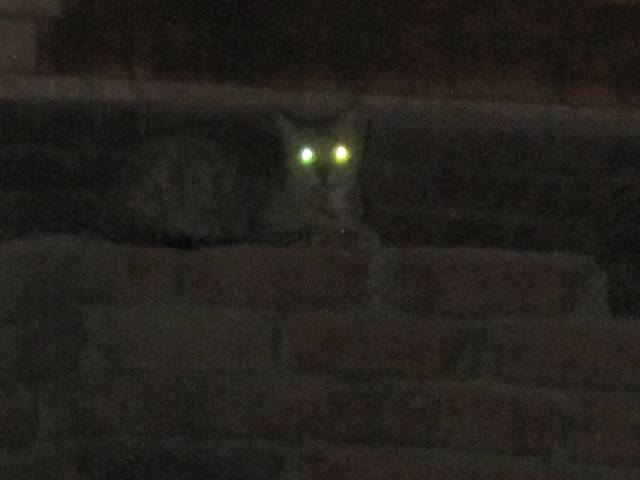 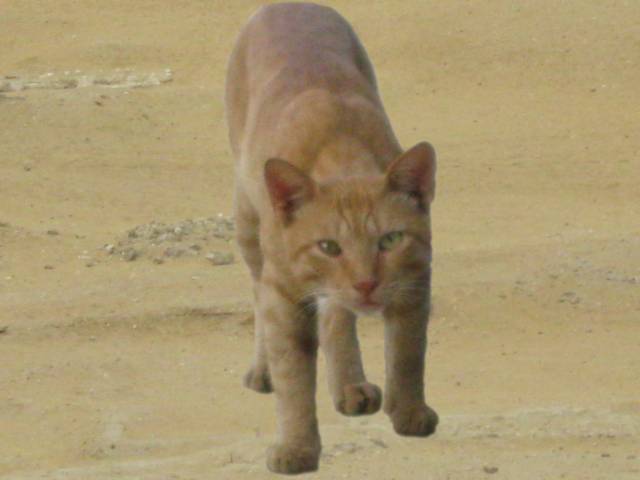
From a time of 3000 years ago and earlier, we know the camel was introduced as a working animal from North Africa. A little later than the Camel, the horse was introduced.
The Hippopotamus by then was on its countdown to extinction in Egypt in less than 2000 years, but from around 700BC and for over a thousand years it was believed that animals could communicate with the gods and were their earthly representatives.
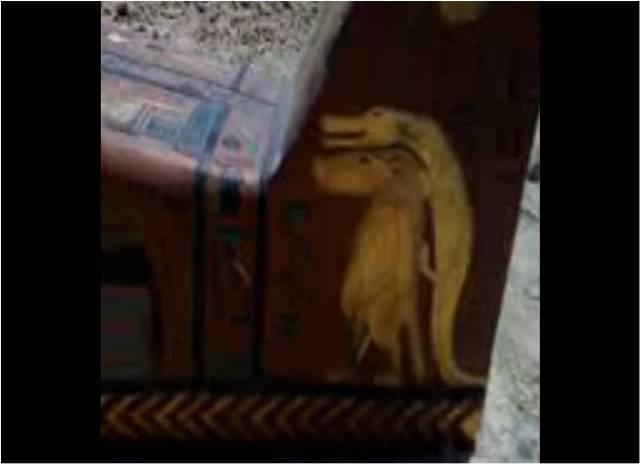 
The following list describes the top ten Egyptian Animal deities.
http://heritage-key.com/blogs/malcolmj/top-10-animal-gods-and-goddesses-ancient-egypt
1. Sobek (crocodile)
Sobek – a huge crocodile god, sometimes shown as a man with a crocodile’s head – was a deity not to be trifled with. He was a huge, fierce beast associated with the idea of the sun going down to sleep at night – like a crocodile plunging deep into water – and being resurrected again in the daytime.
2. Sekhmet (lioness)
The lioness was the fiercest hunter known to the Egyptians, and so the natural embodiment of Sekhmet – a warrior goddess, linked to strength, rage, plagues and healing. Her image is commons in tombs; over seven hundred statues of Sekhmet are thought to have once stood in the funerary temple ofAmenhotep IIIalone.
3. Horus (hawk)
As a god of the sky, sun and war – among other things – Horus was one of the oldest and most dignified deities in ancient Egypt. He therefore wasn’t represented by just any old animal, but a composite “superhawk” – with a falcon’s eyes and an eagle’s plumage among his constituent parts.
4. Thoth (ibis)
Thoth was the Egyptian god of wisdom and writing, who is often depicted as the ibis – a long-legged wading-bird. The ibis’ thin, curved beak looks a little like a pen, so it’s easy to see how the Egyptians associated it with this deity of the written word.
5. Khepri (scarab beetle)
Khepri was linked to rebirth, renewal, and resurrection, and represented by the lowly scarab beetle. This was because of the bug’s habit of laying eggs in the corpses of other animals and in dung – the ancient Egyptians believed this indicated that scarab beetles were actually made of reborn dead matter.
Many of the most deadly species of scorpions in the world can be found in North Africa, so Serqet was kept busy by the Egyptians.
6. Serqet (scorpion)
Serqet was the deification of the scorpion, and the goddess of healing bites and stings – hence her embodiment as a scorpion. Many of the most deadly species of scorpions in the world can be found in North Africa, so Serqet was kept busy by the Egyptians.
7. Bast or Bastet (cat)
Cats were especially sacred animals in Egyptian culture, for their ability to kill rats and vermin and even snakes. Bast, a solar and war goddess, was one of a number of deities that took feline form. Bast’s cult was centered at Bubastis; when her temple there was excavated, more than 300,000 mummified cats were discovered inside.
8. Taweret (hippopotamus)
Male hippos were thought to be evil creatures in cahoots with the god of chaos Set (see below). Female hippos, on the other hand, were seen to be benevolent beasts that represented Taweret, the Egyptian goddess of fertility, childbirth and protection.
9. Meretseger (cobra)
Meretseger – which means “she who loves silence” – was a vengeful goddess said to spit venom into the eyes of criminals. She became closely associated with the Valley of the Kings, and was believed sit on the pyramid-shaped mountain overlooking the ancient Egyptian grave yard, guarding against tomb robbers and vandals.
10. Set (unknown)
God of storms, darkness and the desert Set is interesting, simply because no one can be certain what type of animal he’s is – a composite of an aardvark, donkey and jackal is as close as you’ll get. “He is the god of chaotic forces,” states Ikram. “That’s why he doesn’t look like any one single animal that one can identify.”
http://www.all-about-egypt.com/ancient-animals-from-egypt.html
To the ancient Egyptians, animals were created by the gods and given rights equal to that of mankind. They saw animals not as their subjects, but rather as independent beings, and treated them with respect.
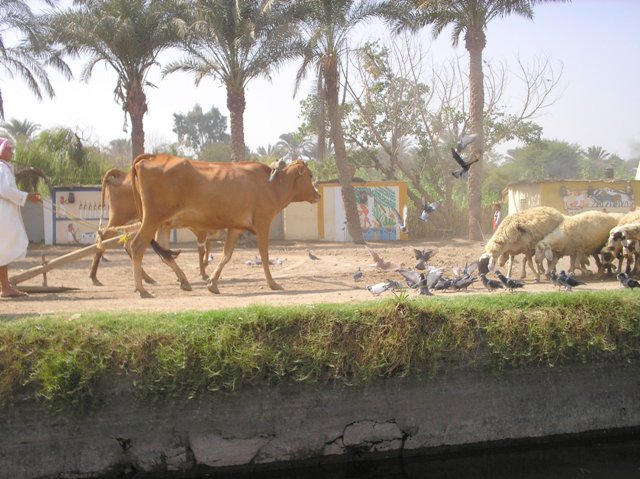
The Nile served as a source of food and was the most important factor to the agriculture of the region. Fish were plentiful and could be eaten roasted, boiled, salted, preserved, or simply dried in the sun. Because the Nile would flood annually, it revitalized the land with water and fertile silt, enriching the soil to grow wheat, fruits, and vegetables. Additionally, it provided thick grasses on which animals would graze
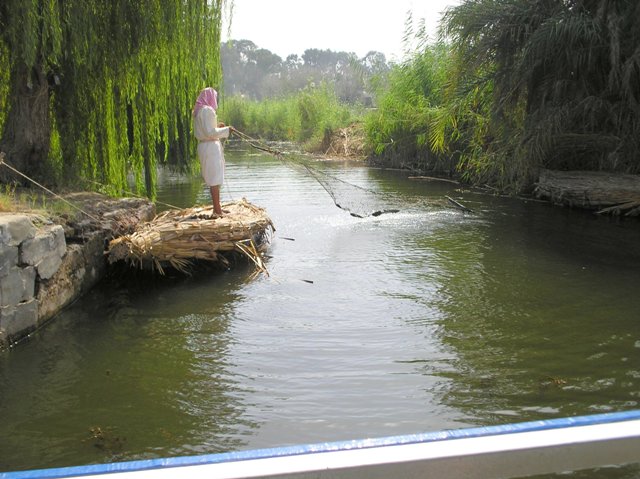
The people of ancient Egypt were mainly pescarian, meaning they would often eat fish. The Nile supplied many types of fish, including: catfish, mullet, tilapia, sturgeon, eel, carp, and perch, which were all an important source of nourishment. Along the Nile, there were restrictions on the types of fish that could be eaten because of their connections with the gods. The Pharaoh and other priests would abstain from eating fish altogether because it was forbidden by one of their deities as a food reserved for peasants.
Bread was their main staple, made from wheat and barley. From time to time, they supplemented their diet with antelope, which they hunted. Occasionally they ate pork and goat, which were raised on farms.
The Egyptians also raised sheep, cattle, geese and ducks. These animals not only provided them with food, drink, leather and skins, but also helped with their daily lives. Oxen and cattle were used forplowing the fields, and other animals were used for trampling seeds into the soil, and eating unwanted grain.
Birds were of extreme importance to the ancient Egyptians as well. Along the Nile, the bird-life included the falcon, kite, goose, crane, heron, pigeon, ibis, vulture and owl. Numerous birds were actually kept in sacred flocks and some were elevated in status to become temple animals. From the vast collection of ancient Egyptian artwork, evidence exists of several species of birds that are now extinct.
Beekeeping began in Egypt around 2500 BC in the Fifth Dynasty. Egyptians loved honey and they would take great pains to cultivate it. They not only kept bees, but they also actively went out and searched for the honey of wild bees. They would use bee wax for embalming, offerings to the gods, medicines, makeup, and as a bonding agent. They named the honeybee after the bull-like god named Apis because they believed it had similar characteristics. (The historian Herodotus described this bull as being black, with a white diamond on its forehead and two white hairs on its tail.)
Horses were introduced much later into Egyptian society around 1500 BC. They were a status symbol for the owners and were mainly used to carry chariots into battle and for ceremonial occasions. Horses were rarely ridden and if so, only by royalty. They were well cared for and given individual names.
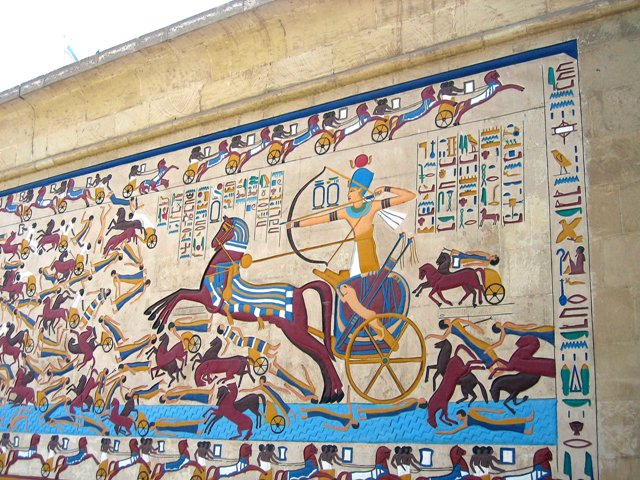
Donkeys were the main beasts of burden. They were used as pack animals and for carrying heavy bundles of grain from the field to the threshing floor. Female donkeys, which produced higher-protein and sweeter milk than cows, were kept as dairy animals.
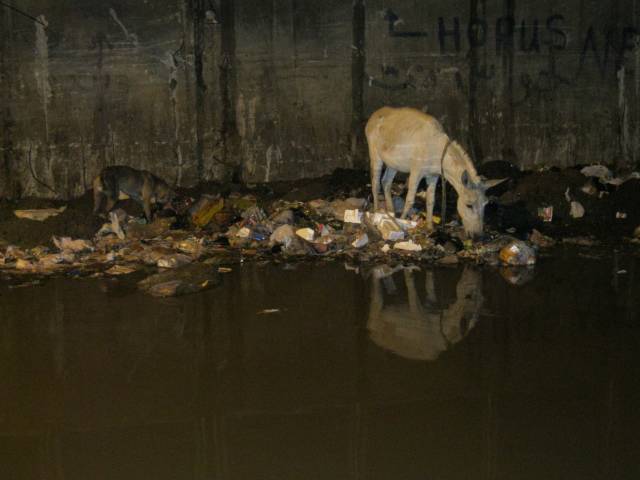
The picture above taken recently in March 2011 following rainfall in Cairo. Stray and starving.
The Donkey and dogs forage in the filth of the flood for more plastic and garbage to swell their stomachs.
Hunting was seen as a symbol of mastery over animal forces. Egyptians believed it was their role to conquer the land. Dogs, resembling greyhounds, would help them while hunting. There is evidence from the tomb paintings that the ancient Egyptians sometimes took along cheetahs they had tamed.
The hunters knew their animals well. They studied their characteristics, including their diet and mating habits. This knowledge brought about a great respect for the animals and aided them in the hunt. Oftentimes, they would hunt great cats, which were not always killed.
Smaller jungle mammals and wild cats, such as the cheetah, were often kept as family pets. Ramses the Great is said to have had a pet lion.
Dog, cats, monkeys, and birds were also a part of the family. So devoted were these ancient people to their pets, that upon the pet's passing, they would often carry out the same rites and rituals as they would for any other family member. Pets and sacred animals were mummified and put in special cemeteries. Animals that belonged to the Pharaoh's royal family were mummified and buried with them so they could continue in the afterlife together.
Dr. Ikram, founder and co-director of the Animal Mummy Project at the CairoMuseum tells us four reasons why animals were mummified.
1. They were mummified because they were sacred.
2. They were mummified to please the animal deities (i.e. as offerings to the gods).
3. The ancient Egyptians believed that the afterlife included animals. Therefore, they wanted their pets to continue with them in the afterlife.
Ancient tombs are time capsules filled with ancient treasures, many of which we are still deciphering and trying to understand. Some of the tomb findings have been items made of animal products, which were used in many ways. Bone was plentiful and the ancient Egyptians fashioned it into jewellery and arrowheads. Glue was made from animal hide and from sinews. Feathers were used as ornaments. Twisted animal gut and sinews were used in the making of stringed instruments. Ivory usually came from Nile hippos and were used for carving combs and jewellery.
Egyptian burials often included sculpted clay and carved wooden figures, tools, and utensils in hopes they would service the dead in the afterlife.
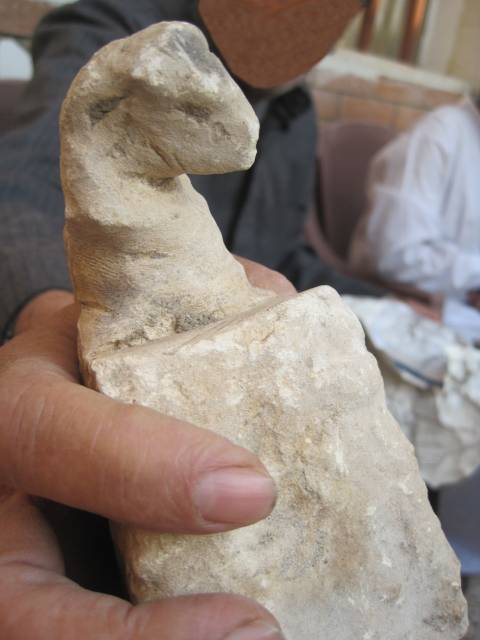 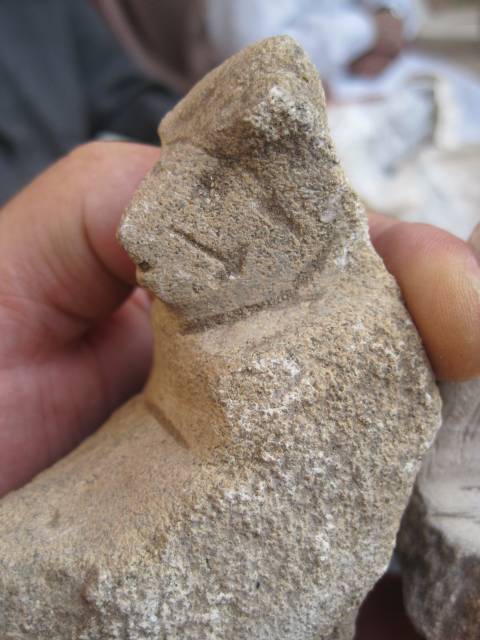 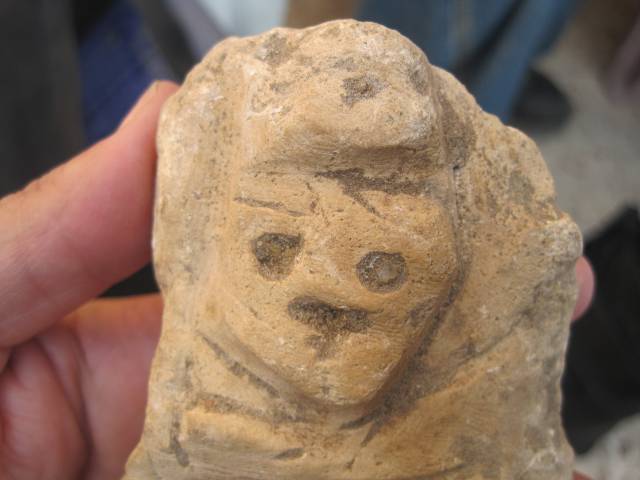
Now animals are starving and dying through abuse and neglect to serve the same masters from the ancestors who
once worshipped and revered them. Can a better way be found again ?
Return now to read Part 5
Our Personal Encounters with animals in Egypt and the desert HERE
~~~~~~~~~~~~~~~~~~~~~~~~~~~~~~~~~~~~~~~~~~~~~~~~~~~~~~~~~~~~~~
Our Appeal
|